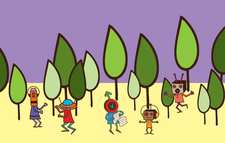Treecle organizes and structures information
Tree-Shaped

Treecle organizes information into categories and bundles it into a neat tree structure. Although the fairly young program shows some minor weaknesses, it is already fit for use.
A corporate structure, a collection of books or recipes, or just a list of tasks – all of these are information collections that you can store in a structured way, if it makes sense to do so. Popular applications such as spreadsheets or word processors are useful for this task, but they have their limitations. For example, it isn't easy to map information to trees in these programs, and that is precisely the target the free Treecle is aiming for: giving users the option of organizing their information into tree structures.
What Is Treecle?
Treecle's name breaks down to A Tree-like Collection of Linked Elements; the program and the source code are available for free from the website [1], which belongs to Indian physicist Kartik Patel. The open source tool is based on the popular Qt framework [2] and was written by Patel to organize his own collection of music and books.
Once Treecle is built locally, or just unzipped, the program gives users the ability to store text and images in large input boxes; the input can be part of a hierarchy or tree. Each branch of the tree stands for a category that can in turn contain subcategories.
[...]
Buy this article as PDF
(incl. VAT)
Buy Linux Magazine
Subscribe to our Linux Newsletters
Find Linux and Open Source Jobs
Subscribe to our ADMIN Newsletters
Support Our Work
Linux Magazine content is made possible with support from readers like you. Please consider contributing when you’ve found an article to be beneficial.

News
-
Zorin OS 18 Hits over a Million Downloads
If you doubt Linux isn't gaining popularity, you only have to look at Zorin OS's download numbers.
-
TUXEDO Computers Scraps Snapdragon X1E-Based Laptop
Due to issues with a Snapdragon CPU, TUXEDO Computers has cancelled its plans to release a laptop based on this elite hardware.
-
Debian Unleashes Debian Libre Live
Debian Libre Live keeps your machine free of proprietary software.
-
Valve Announces Pending Release of Steam Machine
Shout it to the heavens: Steam Machine, powered by Linux, is set to arrive in 2026.
-
Happy Birthday, ADMIN Magazine!
ADMIN is celebrating its 15th anniversary with issue #90.
-
Another Linux Malware Discovered
Russian hackers use Hyper-V to hide malware within Linux virtual machines.
-
TUXEDO Computers Announces a New InfinityBook
TUXEDO Computers is at it again with a new InfinityBook that will meet your professional and gaming needs.
-
SUSE Dives into the Agentic AI Pool
SUSE becomes the first open source company to adopt agentic AI with SUSE Enterprise Linux 16.
-
Linux Now Runs Most Windows Games
The latest data shows that nearly 90 percent of Windows games can be played on Linux.
-
Fedora 43 Has Finally Landed
The Fedora Linux developers have announced their latest release, Fedora 43.

